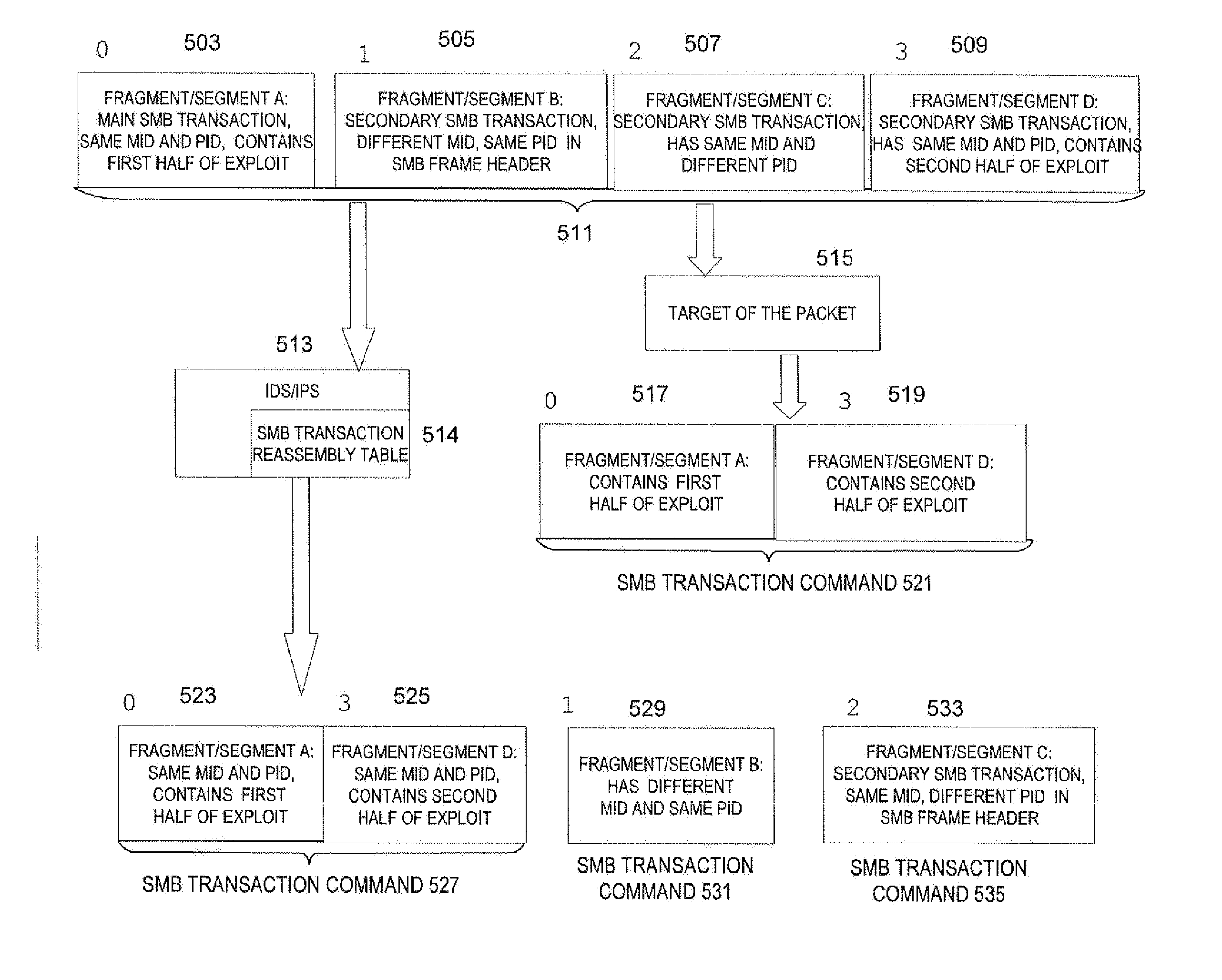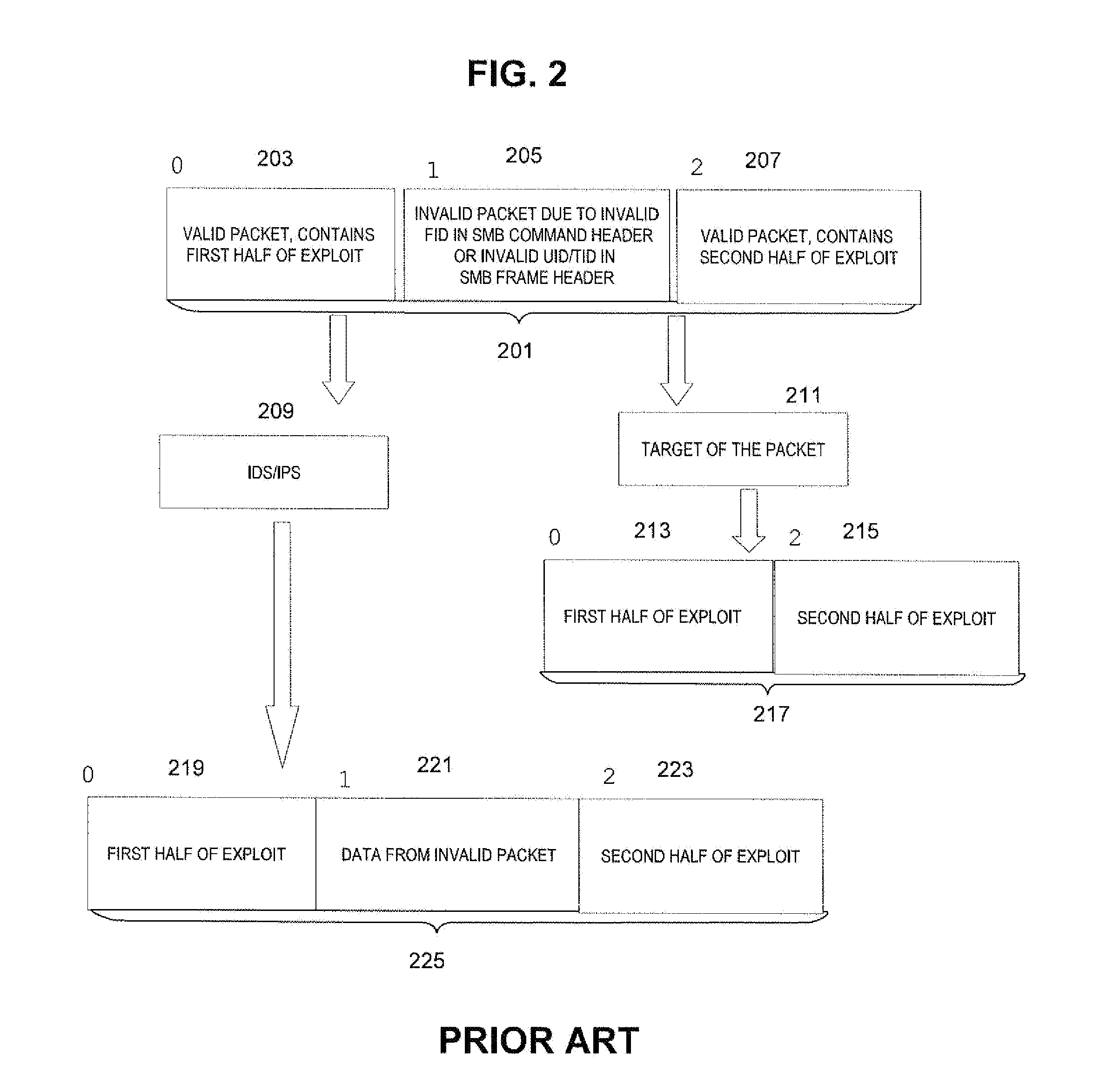Target-based smb and dce/rpc processing for an intrusion detection system or intrusion prevention system
a detection system and intrusion prevention technology, applied in the field of network traffic analysis, can solve problems such as ips/ips missing malicious traffi
- Summary
- Abstract
- Description
- Claims
- Application Information
AI Technical Summary
Benefits of technology
Problems solved by technology
Method used
Image
Examples
first embodiment
[0049]In accordance with known techniques for an SMB named pipe, a user logs in (is assigned a unique UID), opens a share (is assigned a tree id (TID)), and opens an SMB named pipe (is assigned a file id (FID)). Each of the UID, TID, and FID is unique. The standard SMB header has fields for UID and TID and FID.
[0050]Different operating systems and their SMB applications (hereafter, an “OS / application combination”) have different requirements for how to open an SMB named pipe for each of these within an SMB session.
[0051]In some OS / application combinations, it does not matter what UID or TID or FID is used—in other combinations, the FID matters, and perhaps the UID and / or TID matter. In some OS / application combinations, when a file is opened, it matters whether particular UIDs and TIDs are used when that FID is opened—others, not. It is ultimately the SMB layer on the target of the SMB request that handles the SMB request. For Windows, because Windows is closed source it unknown whet...
second embodiment
[0061]The second embodiment further considers the effect of the PID (process ID) and / or MID (multiplex ID) on the reassembly of SMB fragments / segments into SMB transaction commands by the IDS / IPS prior to the evaluation of the transaction commands by the IDS / IPS.
[0062]The transaction command, such as an SMB command, writes data to the named pipe. The MID and PID fields are important if the transaction is segmented. The application at the target needs to keep track of the secondary transaction commands' MID and PID to make sure the segment is being put into the right place.
[0063]A transaction SMB command causes the data to be written to the named pipe only when all of the segments are received by the target. An attacker can interleave an exploit with the secondary transaction commands. Segments for different transaction commands can be interleaved. The MID and PID fields indicate which transaction the segments belong to. In a typical transaction, none of the data is written to the pi...
third embodiment
[0070]The third embodiment further considers the effect of the context ID on the reassembly of DCE / RPC request fragments into DCE / RPC requests by the IDS / IPS prior to the evaluation of the DCE / RPC requests by the IDS / IPS.
[0071]Every DCE / RPC request has a context ID in the DCE / RPC header which is a handle that refers to the interface to which the request is made. If the request is fragmented, each fragment has only a part of the request; each fragment also has a context ID. The fragments are put back together to reassemble the DCE / RPC request. Although the fragments each include a context ID, only one of the fragments needs to have the context ID for the target application to put the fragments back together into the reconstituted request. However, the fragment that the target application selects from which to obtain the context ID is dependent on the target OS / application. For example, WINDOWS(SM) obtains the context ID from the first fragment, but SAMBA contrarily uses the last frag...
PUM
 Login to View More
Login to View More Abstract
Description
Claims
Application Information
 Login to View More
Login to View More - R&D
- Intellectual Property
- Life Sciences
- Materials
- Tech Scout
- Unparalleled Data Quality
- Higher Quality Content
- 60% Fewer Hallucinations
Browse by: Latest US Patents, China's latest patents, Technical Efficacy Thesaurus, Application Domain, Technology Topic, Popular Technical Reports.
© 2025 PatSnap. All rights reserved.Legal|Privacy policy|Modern Slavery Act Transparency Statement|Sitemap|About US| Contact US: help@patsnap.com



